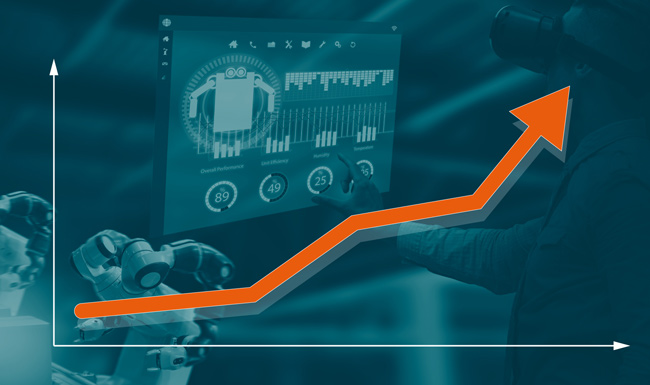
E-Invoicing and Its Geopolitical Stakes
France’s electronic invoicing reform relies on a Y-architecture, where Partner Dematerialization Providers (PDPs) play a central role in issuing and…
Generix Announces the Appointment of Olivier Vaillancourt as General Manager for North America View the press release

After growing by 6.4% during the first quarter on an annualized basis, the U.S. gross domestic product (GDP) is on track to hit its best performance since 1951 this year. According to the New York Times, total domestic economic output should return to pre-pandemic levels by summer with GDP expected to grow by 7.5% overall this year.
“This may be the tip of the iceberg,” Oxford Economic’s Gregory Daco told the publication. “I think we will see much stronger momentum into summer as health conditions continue to improve, policy support remains in place, and employment strengthens.”
Flush with cash due to the multiple stimulus checks, higher unemployment payouts, and the money that they saved up by not traveling and eating out in 2020, American consumers are driving much of the momentum. On the business front, companies are equally as flush and ready to hire new workers, expand their operations, and take on new lines of business.
Combined with other factors, these elements are contributing to a healthy economic outlook for the nation for the foreseeable future.
It’s no secret that global supply chains faced extensive disruptions throughout 2020 and early 2021. And while the pandemic uncovered many supply chain inefficiencies, everyone now appreciates just how essential these networks have become for companies to survive, and thrive, in the “new reality.”
With COVID-19 vaccines now being made available to the entire U.S. population, the economic landscape is poised for yet another seismic shift. The growth isn’t limited to the U.S. The International Monetary Fund (IMF) is projecting global growth at 6% in 2021 (up from a 0.4% decline in 2020), followed by 4.4% in 2022. These estimates reflect additional fiscal support in a few large economies, the anticipated vaccine-powered recovery in the second half of 2021, and continued adaptation of economic activity to subdued mobility.
“Even with high uncertainty about the path of the pandemic, a way out of this health and economic crisis is increasingly visible,” IMF chief economist Gita Gopinath said in the latest World Economic Outlook (WEO) report. CNBC says the latest forecasts suggest that the U.S. is well placed to experience a solid economic recovery in 2021, in contrast to much of the world, where it’s likely to take longer to return to precrisis levels.
CNBC reports that U.S. unemployment is expected to fall from 8.1% in 2020 to 5.8% this year and to 4.1% in 2022.
Coming off a banner year that pushed its annual revenues up by 44% over 2019, e-commerce sales continue to sit in the driver’s seat for much of this expansion. In the U.S., e-commerce penetration experienced the equivalent of 10 years of growth during the first three months of 2020’s spring season, and warehouse operations need to be prepared to manage and exploit this growth.
Companies that ignore this reality do so at their own peril: According to Gartner, by 2022 the organizations using multiple go-to-market approaches for digital commerce will outperform the sales of non-commerce organizations by 30 percentage points.
In Forbes, Futurum Research’s principal analyst Daniel Newman pinpoints inventory management as one of the primary culprits during eras like the great toilet paper shortage of 2020, when both manufacturers, distributors, and retailers alike were caught off guard by the spike in demand.
“Companies did not have a solid understanding of how much inventory they had, where it was, either in the country or across the globe, how much their suppliers had, and the timetables it would take to create and ship inventory amidst growing demand,” Newman writes.
“To be fair, in the early part of the pandemic, there were vast discrepancies between expected demand and actual demand for many semiconductor intensive items like mobile devices, laptops, and even automobiles,” he adds. “With the economy set to be in turmoil, it wasn’t expected that there would be such robust demand in these areas.”
“The utilization of data, machine learning, and the right expertise rose to the top as a necessity for businesses to stay competitive and reduce supply chain risk,” he adds. “Investment in this area is a digital transformation must.” Through this experience, companies learned that many of these disruptions can be circumvented – or, at least minimized – with good supply chain visibility. This is something many companies realized that they didn’t have when COVID-19 emerged and dramatically changed the way people and business buy goods.
As companies prepare for the second half of 2021 and ramp up to meet the demands of the recovering national economy, technology will continue to play an important role in this evolution. With the GDP continuing to increase, consumers ready to spend, and a robust summer travel season right around the corner, the time to get your supply chain in shape and ready to grab these opportunities is now.
Generix Group North America provides a series of solutions within our Supply Chain Hub product suite to create efficiencies across an entire supply chain. From Warehouse Management Systems (WMS), Transportation Management Systems (TMS) to Manufacturing Execution Systems (MES), such platforms can deliver a wide range of benefits that ultimately flow to the warehouse operator’s bottom line. Our solutions are in use around the world and our experience is second-to-none. We invite you to contact us to learn more.

France’s electronic invoicing reform relies on a Y-architecture, where Partner Dematerialization Providers (PDPs) play a central role in issuing and…

The B2B mandate in Germany, set to take effect on January 1, 2025, marks a crucial step in the European…

Following the October 15 announcement regarding the abandonment of the PPF development, the DGFIP and its partner AIFE are ramping…

Work with our team to build your ideal supply chain software stack and tailor it to your unique business needs.